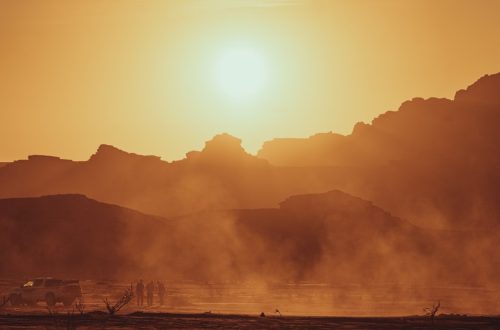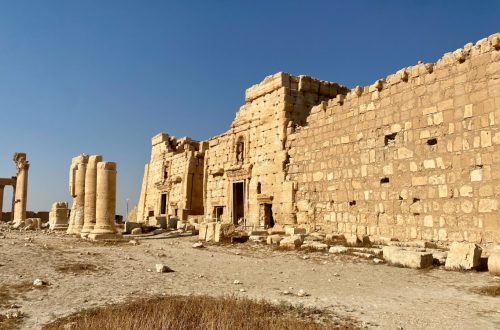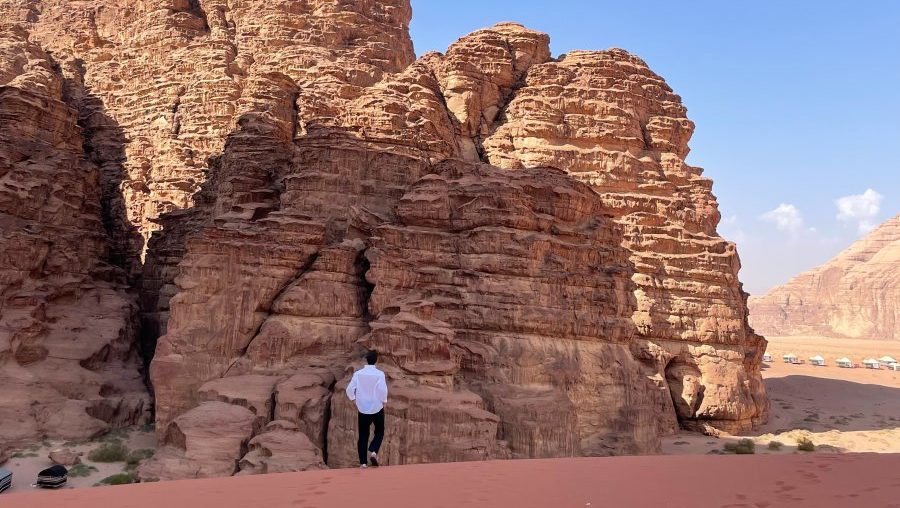
Why you should Plan a Trip to Wadi Rum in 2024
Few places in the world hold such a sense of wonder and awe as Wadi Rum, Jordan. located in the middle of the Jordanian desert, it’s a place of extreme beauty, a place where you’ll get the feel of being in another planet.
With this guide, I aim to answer all the questions you might have and make the case for why you should plan a trip to Wadi Rum in 2024.
If you are wondering how to plan a trip to Jordan and you’re struggling to find all the information you need, head to my complete guide for the country. You won’t regret it!
A Little Bit of History
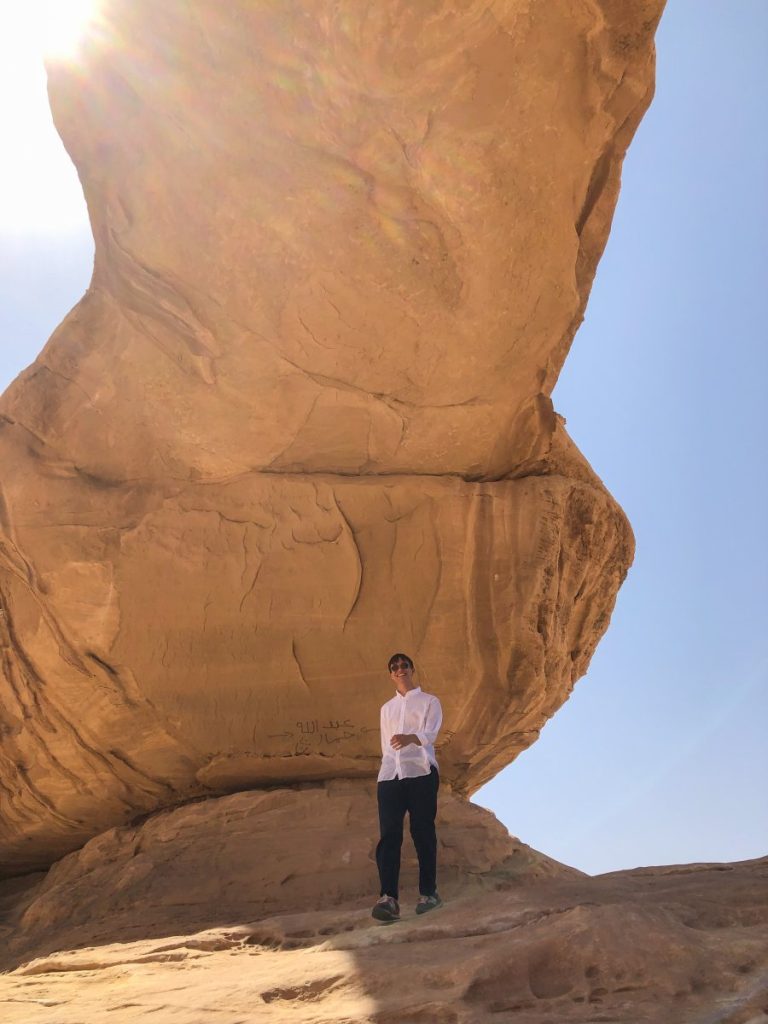
Wadi Rum, also known as the Valley of the Moon, is a stunning desert landscape in southern Jordan. Its history dates back to prehistoric times, with petroglyphs and inscriptions found throughout the area that tell tales of long-gone civilizations.
The area was first inhabited by the Nabateans, an ancient Arab people who left their mark with rock paintings, graffiti, and temples. They were known for their skill in water management, a crucial ability in such a harsh desert environment.
Over the centuries, Wadi Rum has been a crossroads for various cultures and civilizations. It was part of the Roman Empire, and later the Islamic Caliphate. Each left their own unique imprint on the landscape.
In more recent history, Wadi Rum gained fame during World War I. It was here that British officer T.E. Lawrence, better known as Lawrence of Arabia, based his operations. His exploits were later immortalized in the famous film ‘Lawrence of Arabia’.
Today, Wadi Rum is a protected area and a popular tourist destination. Its unique combination of history, culture, and natural beauty make it a perfect place to put on top of your Bucket List.
Is Wadi Rum Safe to Visit?
Wadi Rum holds a reputation for being an extremely safe tourist destination. The local Bedouin residents take pride in their hospitality and care deeply about the safety of their visitors. However, as with any adventurous excursion, it is always wise to keep some key safety tips in mind.
Firstly, even though Wadi Rum is generally safe, it’s always important to have travel insurance just in case of any unexpected emergencies or health issues.
Safetywing’s Nomad Insurance is one of the best options available out there. With a maximum coverage of 365 days, they are a great option whether you are a Nomad or not! They offer very low rates, but excellent coverage and immediate support (in a few minutes!). The best part? Nomad Insurance can be purchased even if you have left your home country already.
Lastly, they also cover extreme sports, something that can come in very handy if you are planning to travel to Wadi Rum!
The desert terrain can be treacherous if you’re not careful. Always stay with your tour group, stick to established routes, and follow the advice of your experienced local guides.
Moreover, stay hydrated. The desert can be deceivingly dry, and water stations are few and far between. Pack plenty of water and regularly replenish your fluids to avoid dehydration. Also, remember to protect your skin from the strong desert sun by wearing a hat, sunglasses, and plenty of sunscreen.
Preparing for your journey with these safety measures in place will ensure you have an enjoyable adventure through this breathtaking desert landscape.
What is the best season to visit Wadi Rum, Jordan?
Choosing the right season to visit Wadi Rum can have a big impact on your experience. Below you’ll find all the important information about seasons in the majestic Jordanian desert.
Spring (March – May): This is undoubtedly one of the most beautiful times to visit Wadi Rum. Wildflowers bloom across the desert landscape, bringing a bit of color to the typically yellow and red surroundings. The weather is also just about perfect – sunny days with manageable temperatures and relatively clear skies.
Summer (June – August): Summers in Wadi Rum can be quite tough, with temperatures spiking well above 100°F (38°C). Despite the heat, this is perhaps the best season for stargazing, as the skies are clear, bright, and typically free from sandstorms. However, day-exploration might be less enjoyable due to the scorching sun.
Autumn (September – November): Autumn can be likened to spring in terms of weather. The temperatures become quite pleasant, creating optimal conditions for daytime exploration. However, be prepared for occasional wind and dust storms that may greatly affect visibility.
Winter (December – February): The winter months bring a different kind of beauty to the desert, but also a harsh chill, particularly at night. With temperatures dropping close to freezing point, adequate clothing is a must. On the brighter side, it’s low-tourist season, and you will be able to enjoy your desert adventures in relative seclusion and at better prices.
How can I reach Wadi Rum from Amman?
Traveling from Amman, the capital city of Jordan, to Wadi Rum can be an experience in itself. You’ve got multiple options, and what you choose largely depends on your preferences and time constraints.
Firstly, you have the option to catch a direct JETT bus. It operates from the Abdali station in Amman. Typically, it leaves at 6:30 AM on Tuesday, Thursday, and Sunday, taking around 4 to 5 hours to reach Wadi Rum. While this is a cost-effective method, it may require some planning to match the bus schedules.
If you appreciate freedom of schedule and pace, consider hiring a taxi or a private car. Although this option is pricier (It will set you back $150-200), it offers a sense of flexibility. You get to control your journey, make stops at interesting sites along the way and reach Wadi Rum at your convenience. The drive from Amman takes approximately four hours.
But, if you’re seeking ultimate control over your journey, why not rent your own car? This can provide the most tailored and flexible travel experience for your trip.
Can I rent a car for my trip to Wadi Rum?
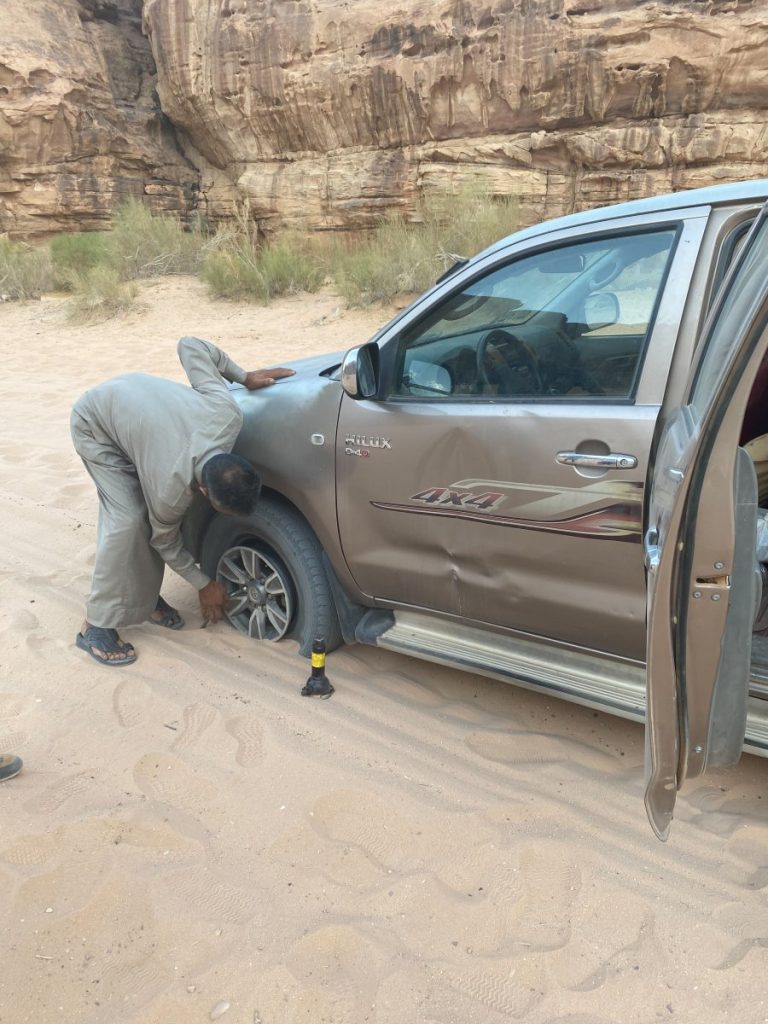
Rental vehicles provide a fantastic way to explore the rich landscapes surrounding Wadi Rum. However, please note that only 4×4 vehicles are allowed in the desert. That’s why you’ll have to leave your car at the Wadi Rum visitor’s centre, and your camp provider will take care of everything else.
Rental car companies are available in masses in Jordan, including international and local options. Depending on the type and size of the vehicle you select, you can expect to pay between $25 to 50 per day.
Therefore, I would suggest Monte Carlo car rentals (A local Jordanian Rental agency) with an open heart, as my experience with them was terrific. They offer the lowest fares we could find in the country, and they even gave us more perks than what we’d asked.
While renting a car and exploring freely provides a great sense of adventure, be aware that it requires some experience in driving. Make sure you also keep an eye on your gas level due to the sparse distribution of gas stations in the area.
Always fill up your tank whenever you get the chance. I’d also recommend to make sure that you have a spare tire and a jack, as flat tires may occur while traversing the rugged desert terrain.
How much time should I plan for a trip to Wadi Rum, Jordan?
Truth be told, the amount of time you spend in Wadi Rum, Jordan is largely dependent on what you seek during your visit. Wadi Rum has indeed something for everyone. For a quick visit, you might manage to squeeze in the major attractions in one full day. If you desire a more comprehensive experience, a delightful 2 to 3 days stay would be ideal.
If your itinerary permits, making room for more days would only enhance your experience. It will give you the opportunity to dig deeper into the desert wilderness. Not least, is the charm of the night sky that calls for a stay-over in the desert camp.
A reminder! Wadi Rum is huge, and its secrets are delicately buried in its sandy corners. Therefore, don’t rush, instead allow yourself time to cherish the magical terrains of this Martian landscape.
Is there Internet or mobile connectivity in Wadi Rum, Jordan?
While you may organize your trip to Wadi Rum to disconnect from the digital world and immerse yourself in nature, you’ll still want some level of communication ability. The great news is, despite its remote location, Wadi Rum does provide basic internet and mobile connectivity. Nevertheless, the connection may be weaker compared to urban areas and might fluctuate, primarily due to the desert environment.
Mobile network providers in Jordan offer coverage in most parts of Wadi Rum, enabling you to make phone calls and use mobile data. However, please note that the strength of the signal varies throughout the desert, with some areas having stronger reception than others.
If staying connected to the internet is important during your visit, it’s advisable to stick to the main camp areas and visitor center where you’ll find Wi-Fi facilities. Most of the desert camps also provide Wi-Fi services for guests. But keep in mind, the connection may not be as fast and reliable as in the city.
It’s wise to verify the connectivity options with your tour operator or accommodation provider before you plan your trip. Remember to download offline maps, tour guides, and other necessary information prior to your journey. This way, you can enjoy the rustic beauty of Wadi Rum without worrying about missing your connection to the outside world.
What kind of clothing is suitable for Wadi Rum’s climate?
Being in the heart of the desert, Wadi Rum’s climate can be quite variable. During the day, especially in the summer, temperatures can soar up to 40 degrees Celsius (104 degrees Fahrenheit). On the contrary, the nights can be surprisingly cool, with temperatures falling as low as 4 degrees Celsius (39 degrees Fahrenheit) during the winter.
Given this, it’s vital that you come prepared for both the heat and the cold. A pair of sunglasses, a hat, and sunscreen are essentials for protecting you from the harsh sun during the day. Lightweight, breathable clothing is also recommended to keep your body cool and comfortable.
When the sun sets, the desert can get very cold very fast. You’ll go from wanting to jump in a pool to wishing for a warm fire in a blink. Make sure to pack at least one set of warm clothes- think thermal layers, a fleece or sweater, and even a hat and gloves if you’re planning to visit during the colder months.
Don’t forget about your feet as well! Sturdy trekking shoes or boots are strongly advised for the rocky terrain of Wadi Rum. Sand can be quite annoying if it gets into your shoes, so consider high-cut boots or even gaiters.
Mind that this is a conservative country, so it’s generally a good idea to avoid wearing revealing clothing out of respect for local norms.
Are there any guided tours available in Wadi Rum?
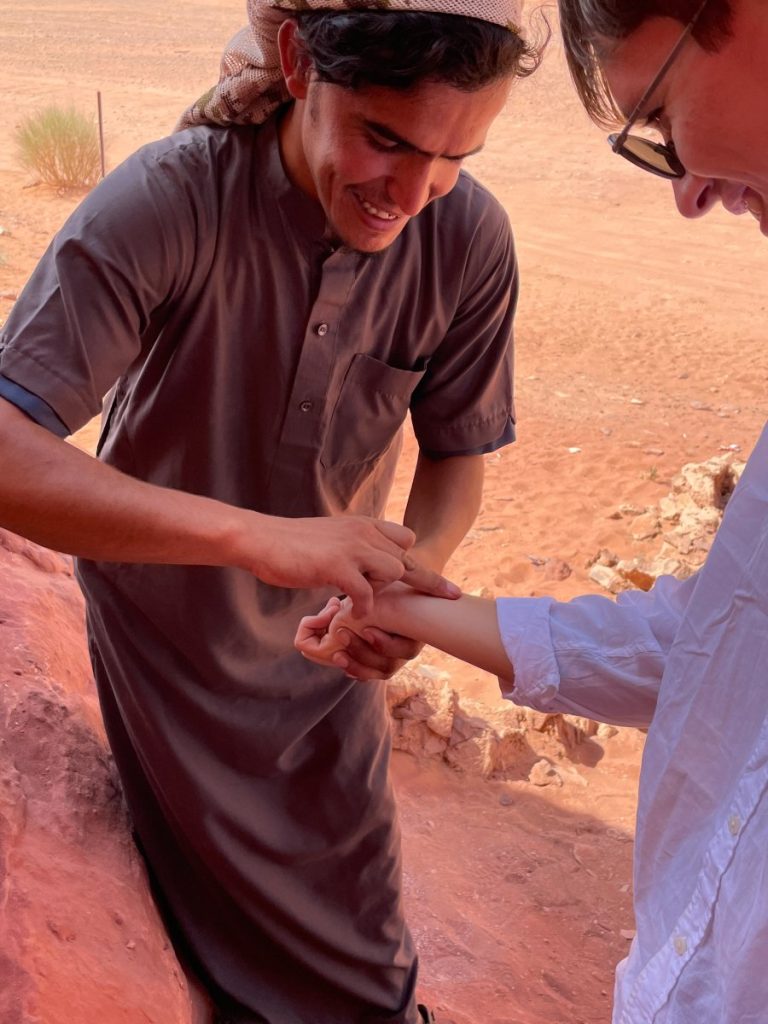
Indeed, there are multiple options for guided tours in Wadi Rum, both for groups and individual travelers. Many local companies offer a range of packages, from full-day excursions to extended overnight stays.
Nearly all the tours provide visitors with the chance to explore the highlights of Wadi Rum, such as the Lawrence Spring, Khaz’ali Canyon, and the renowned ‘Seven Pillars of Wisdom’. Hot air balloon rides are also a popular activity offered by some tour operators, providing a unique bird’s eye view of thewhole desert.
Furthermore, some tours propose a more immersive experience, allowing guests to engage with local Bedouins, partake in traditional cooking, and even sleep under the stars in Bedouin tents. These itineraries provide a unique view into the lifestyle and customs of the indigenous peoples who have inhabited this region for centuries.
Prices vary depending on the duration and activities included in the tour. It’s recommended to check out different tour operators’ reviews and ratings online to get a sense of their credibility and the quality of the experience they provide. Don’t forget to ensure that they follow ethical standards, especially if the tour includes any interaction with animals.
What are the currency and payment options in Wadi Rum?
When planning your trip to Wadi Rum, it’s equally crucial to consider the financial aspects. The official currency of Jordan is the Jordanian Dinar. While most establishments in the larger cities accept credit and debit cards, using cash is often preferred in remote areas like Wadi Rum. Therefore, it’s a good idea to keep some amounts of cash handy for covering transportation costs, meals, or souvenirs.
ATMs aren’t commonly found in the desert, meaning you should withdraw enough money before heading into Wadi Rum. If your bank charges international transaction fees, consider withdrawing larger sums at once to save on these charges. Keep your cash safely stored in a money belt or hidden pouch for extra security.
While credit cards are usually acceptable at luxury camps or upscale dining establishments in the desert, their acceptance isn’t a guarantee. Having a few backup cash options is always a beneficial plan. Don’t forget to call your bank before your trip and set up a travel alert. This measure ensures that your bank knows you’ll be using your card abroad and doesn’t block your transactions thinking they are fraudulent.
Lastly, tipping is common in Jordan. As a rule of thumb, you should be prepared to tip around 10% in restaurants and small amounts to guides, drivers, and any other service staff.
What kind of accommodation options are available in Wadi Rum?
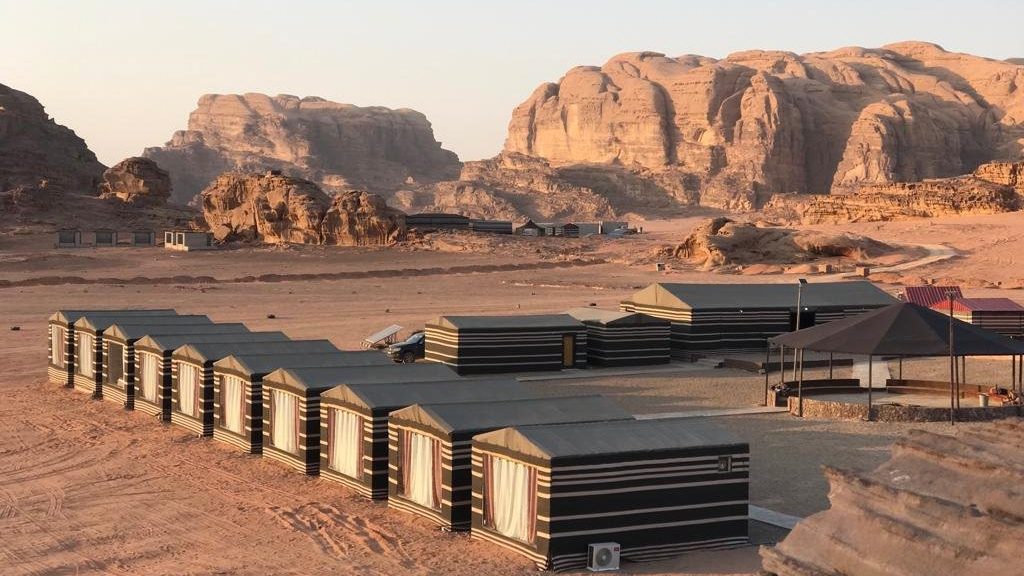
Accommodations in Wadi Rum, Jordan, range from the traditional to the luxurious and modern, offering a range of options suited everyone’s tastes and budgets.
Among the most unique and famous in the region are the Bedouin-style camps. These camps, ran by the native Bedouins, provide a rare chance for immersion in the Jordanian culture. You’ll stay in comfortable, well-appointed tents arranged in a circular format. As the sun sets, you’ll experience the traditional Bedouin hospitality around a crackling fire, with rich teas and authentic meals.
If on the other hand you’re looking for something a little more luxurious, there are also several high-end luxury camps. These resorts often come with a higher price tag, but the upscale amenities are absolutely worth it.
We stayed and organized everything with Miral night camp. They were excellent proffesionals, their prices were great and the tents very comfortable. The tents offer individual bathrooms and fans, so that you don’t suffer during the Summer Months. I cannot recommend them enough!
What wildlife can I expect to see during my trip to Wadi Rum?
Visiting Wadi Rum, Jordan is tantamount to a wildlife expedition, where you can witness nature in its raw, unfiltered form. While many of the desert’s inhabitants are remarkably adept at camouflage, with a careful eye and perhaps a guide at your side, you can spot a variety of fascinating species native to this region.
As you navigate through the landscapes, the most common creatures you’ll encounter are the desert species of rodents and lizards. The Sinai agama lizard, brightly colored and usually found basking on rocks, makes for a captivating sight. Rodents like the jird and gerbil are indigenous to this terrain, and while they are usually wary of humans, spotting them is not too rare a luxury.
If you’re a fan of feathered creatures, Wadi Rum does not disappoint. The desert eagle owl, brown-necked raven, and the desert lark are some of the bird species that call this area home. You’ll also be privy to the magnificent flight of the griffon vulture, native to these parts.
Among larger fauna, the Arabian oryx and the Nubian ibex, a type of wild goat, were once common here but their population has dwindled due to hunting and habitat loss. With luck and patience, you might catch a glimpse of these elusive creatures.
Scorpions and snakes also inhabit the desert but are rarely encountered during daylight hours. However, it doesn’t hurt to be cautious and stick to marked trails whenever possible for safety reasons.
If you’re up for an adventure, you can challenge yourself by sandboarding down the dunes. Feel the exhilarating rush as you slide down the towering, sandy slopes. It’s an activity that’s both fun and challenging, making it a perfect exciting diversion for children, teens, and adults alike.
What local dishes should I try in Wadi Rum, Jordan?
Experience the authentic taste of Jordan while visiting Wadi Rum by relishing its traditional dishes. Your trip to this desert land is incomplete without savouring its native cuisine.
Zarb: This Bedouin-style dish is a must-try. It comprises of meat (usually chicken or lamb), and vegetables that are slow-cooked in an oven dug in the sandy desert ground. The special cooking method gives the dish a unique smoky flavor, that is exceptionally satisfying.
Mansaf: Mansaf is the national dish of Jordan. It’s a traditional dish made of lamb cooked in a sauce of fermented dried yogurt and served with rice or bulgur. A meal experience that promises to be both sumptuous and flavourful, Mansaf is a definite must-try.
Mutabbal: A classic Middle Eastern appetizer, Mutabbal is made from finely diced and roasted eggplant blended with tahini (sesame paste), lemon juice, garlic, and olive oil. It’s perfect to enjoy with warm flatbread.
Kaek Bread: Let’s not forget about Jordan’s go-to street food, Kaek Bread. This sesame-encrusted bread is typically filled with cheese or za’atar (a traditional spice blend).
Bedouin Tea: To wash it all down, don’t miss out on the traditional Bedouin tea, often served with generous amounts of fresh mint.
What are the Best things to do in Wadi Rum?
When visiting Wadi Rum, it’s an absolute must for you to try as many of the thrilling desert activities as possible. After all, you’re in one of the world’s most famous deserts. Here are some recommendations for an unforgettable experience:
1. Jeep Safari
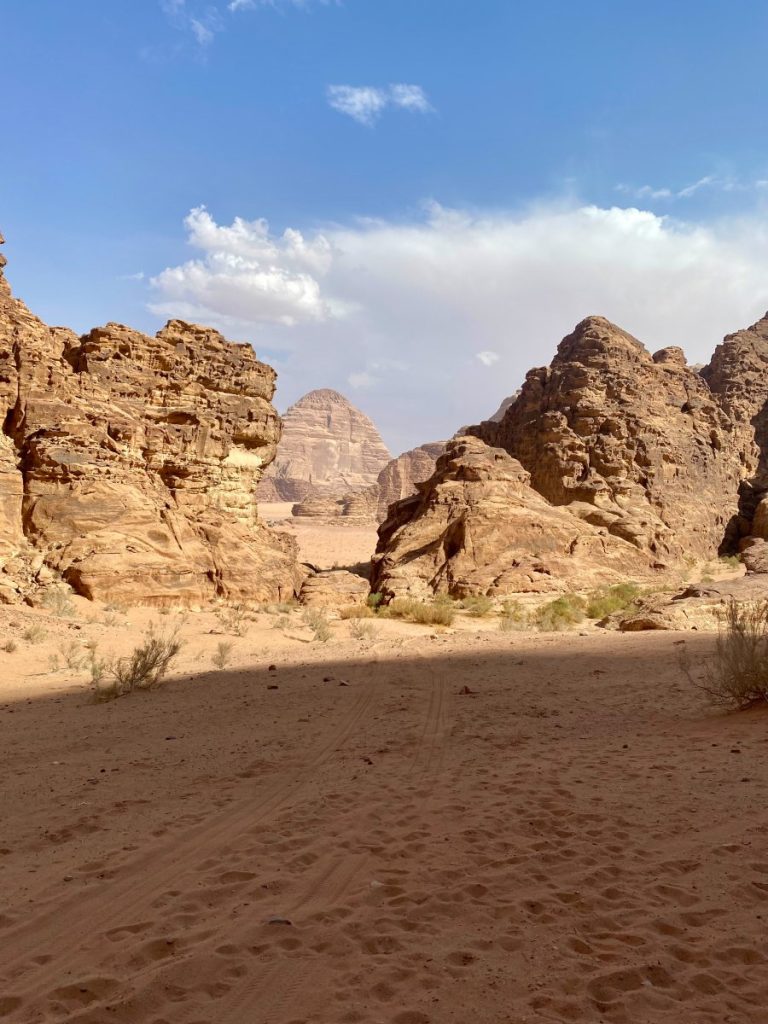
A jeep safari is an exciting way to explore Wadi Rum’s lunar landscapes.J eep Safaris are typically guided tours, led by local Bedouin guides who have an excellent knowledge of the desert. They can take you to hidden gems and points of interest that you might not find on your own. These can include ancient rock formations, prehistoric petroglyphs, and stunning viewpoints.
Depending on your preferences and the time you have available, Jeep Safaris can last anywhere from a few hours to a full day.
During the safari, you’ll have the opportunity to stop and explore on foot, climb sand dunes, and even enjoy a traditional Bedouin meal. It’s a great way to immerse yourself in the local culture while experiencing the desert’s unique ecosystem.
Despite the rugged terrain, the Jeeps used for these safaris are typically well-maintained and equipped with necessary safety features. However, it’s important to remember that desert conditions can be harsh, so it’s recommended to bring sun protection, water, and appropriate clothing.
2. Camel Riding
A trip to Wadi Rum isn’t complete without riding a camel. Camels have been used for centuries by Bedouin tribes for their ability to travel long distances without water. Riding these creatures gives you a glimpse into the nomadic lifestyle of the Bedouin people.
A traditional camel ride is both fun and educational, offering insight into the ancient way of life in the desert.
3. Rock Climbing
For the adventurous spirit within you, rock climbing in Wadi Rum’s designated sections can be absolutely thrilling. Always remember to respect the rules, hire an experienced guide, and bring along all necessary safety equipment.
4. Balloon Rides
Hot air balloon rides are one of the most popular activities for tourists visiting Wadi Rum. These rides offer a unique perspective of the stunning desert landscape, allowing you to admire the full extent of the red sand dunes, mountains, and rock formations from up above.
During the balloon ride, you’ll ascend to heights of up to 1,000 meters, providing breathtaking views of Wadi Rum’s iconic landmarks such as the Seven Pillars of Wisdom, a natural rock formation named after the book by British officer T.E. Lawrence (Lawrence of Arabia).
Balloon rides in Wadi Rum are conducted by experienced and certified pilots, ensuring your safety throughout the journey. Most companies also provide a traditional Bedouin breakfast after the ride, giving you a taste of the local culture.
Booking a balloon ride in advance is highly recommended, especially during the peak tourist season. Prices can vary, but generally, you can expect to pay around 130 to 150 Jordanian Dinars per person. This may seem pricey, but the unforgettable experience and the stunning views of the desert landscape make it well worth the cost.
5. Stargazing
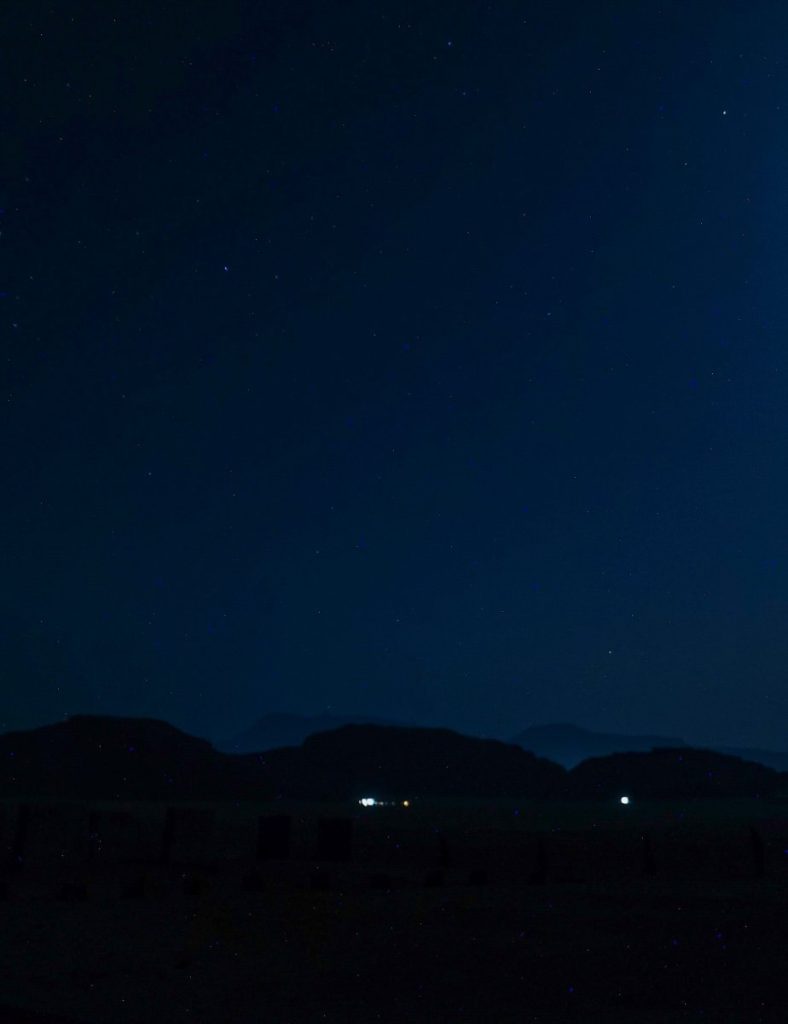
End your day by laying back and observing the clear night sky. Wadi Rum’s remoteness makes it a stargazer’s paradise, where you can trace constellations, watch for shooting stars, or simply marvel at the cosmic beauty overhead.
Final Thoughts
Visiting Wadi Rum is a one-of-a-kind experience that no description can fully express. While this guide aims to provide you a complete view of traveling to Wadi Rum, Jordan, the authentic joy of exploration is in the unpredicted, the unanticipated little experiences that, when woven together, create your unique travel tale.
From the moment you step foot in this magical land to your return journey, embrace the moments, immerse yourself in the culture, and let the stillness of the desert seep into your soul. Adventures are waiting at every turn – it’s an experience, an emotion, a story waiting to be told.


